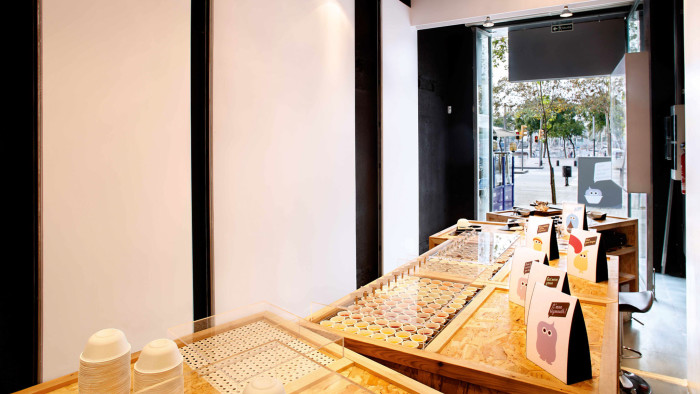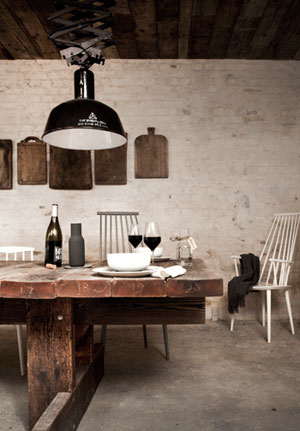In good taste

Simply sign up to the Life & Arts myFT Digest -- delivered directly to your inbox.
Whether it be neon light installations, bespoke chandeliers, leather ceilings or graffiti walls, the use of design in bars and restaurants has become the norm. Well thought-out interiors and clever branding are good for business, and interesting design is now as likely to be found on the high street as in high-end establishments.
Indeed, this year’s entrants to the Restaurant & Bar Design Awards, celebrating the best of design in the UK and internationally, range from Nando’s to Sketch; past winners include Galvin La Chapelle, Costa Coffee and the Barbican Lounge. So what stands out? Ahead of the announcement next week of the shortlists, three judges tell us what caught their attention this year.
…
David Kester, director, Thames & Hudson
“At the end of the 20th century we all embraced the arrival of big brands. Now there is a reversal, and larger organisations are having to be creative in localising their design. The Byron burger restaurants in London are a good example, many of which were designed by Ben Stott. Each restaurant is unique, so in the West End the decor is all about the theatre world whereas in Putney it is about locals and the river and has a different feel. We’ve seen the same with Giraffe and PizzaExpress. I think this has a lot to do with the changes we are seeing in our high street and the desire for a ‘central locality’.

Allied to this is a desire for greater authenticity. The Höst restaurant in Denmark, designed by Norm Architects, brought a bit of rural Scandinavia into urban Copenhagen: very beautiful, minimalist but natural with vintage wooden chopping boards on the wall and woollen throws. It gave a real sense of what it is to be Danish.
A sense of playfulness is another trend that has struck me this year, for example, the ice-cream parlour Eyescream and Friends in Spain, designed by Estudio M Barcelona. The branding is brilliant. They sell Taiwanese ice-cream, which tastes delicious but is not very attractive, so they came up with the idea of creating little monsters with it. It is a food experience – not just a graphic concept plonked on top of an idea – done with great wit.
Restaurants are realising that design is not a cost, it is a must. If you don’t put the design effort in then you won’t get the experience out, which is what people crave.”
…
Stephen Alden, chief executive, Maybourne Hotel Group
“The first step to get a restaurant to work is getting the layout right, so that navigating the space becomes more intuitive. I’ve seen a lot of interesting conversions recently – for example, the work done to create Caravan out of a Grade II-listed granary in King’s Cross, London. The architect and designers, RR Studios and Harper + Hinton, have created a space that feels genuine with its industrial fixtures and details, such as factory cabinets and lighting, and fits superbly in its surroundings.
People look for places that are about drama because that builds a special experience. Tramshed, a Grade II-listed former substation built in 1905, has been executed to great effect. Here the dining by Mark Hix is simple and focused, centring around steak and chicken. The main design element, Damien Hirst’s formaldehyde-filled tank ‘Cock and Bull’, featuring a cow and a cockerel, reflects the menu.”
…
Janet Wardley, head of visual display, Harvey Nichols
“Places have got simpler and less glamorous and stuffy. I like restaurants that show a degree of informality or use mismatched tables and chairs to create a more relaxed environment. I think design is exciting when it is a bit rougher around the edges.
Bar & Co in Finland, designed by Joanna Laajisto Creative Studio, is simple and uses natural materials; I also like Apero in London, by Dexter Moren Associates, which is minimal with functional lights and painted brickwork. It is designed but not overdesigned.
I have seen an increasing trend towards displaying artwork. Nando’s in Aberdeen – designed by Moreno:Masey – used an artist who chipped away at the brickwork of the building to form images in it. Another example is the pyramid-shaped Atrium Champagne Bar [at ME Hotel, London], by Foster+Partners, which has projections all around the walls.
I think we’ll continue to see restaurant design that doesn’t overtake the food, so the focus is on the experience and the taste. I like the idea of collaborative dining groups like Outstanding in the Field, who set up restaurants in fields or farms. Sometimes I’d rather sit on a bench somewhere and eat something different. It is a bit more fun, more relaxed, about being there and taking part.”
www.restaurantandbardesignawards.com. This year’s ceremony will be held at London’s Farmiloe Building on September 12
Comments